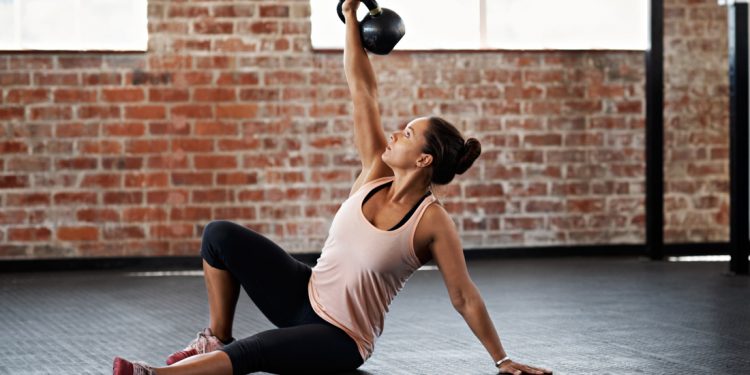There are few training tools in the fitness mainstream that pique interest and create more discussion than a kettlebell exercise or workout. For some, an intimidating ball of iron, for others a versatile piece of equipment that with proper training can transform your body.
While kettlebell swings, cleans, jerks, and snatches offer unique challenges in terms of proper skill and execution, the Turkish Get-Up (TGU) is, without a doubt, one of the more complicated lifts to master. The TGU, however, is unique in that it has multiple parts that can be practiced as stand alone exercises, then put together for safe, seamless execution.
Check out the NASM Exercise Library for more great exercise demonstrations!
Why a Turkish Get-Up?
The TGU is a complex, integrated exercise that improves flexibility, joint mobility, and overall body strength. It also helps strengthen and stabilize the core, while also improving balance and coordination. Along with being a great lift, the TGU can also be used as an assessment tool to spotlight areas of the body that may be tight, such as the hips, or areas that may need strengthening, such as the shoulders. Overall movement quality can also be assessed with this total body exercise.
Safety Tip:
Whether you’re using the TGU as an assessment tool or you’re in the beginning stages of learning or teaching it, it’s good to practice without load, or a very light object like a shoe. With the many moving parts and coordination required for the TGU, it can be challenging enough using just body weight without adding in the additional control needed for a loaded movement. The goal is to focus on quality of movement over load or quantity.
How to Perform the Turkish Get-Up
Set Up:
- Lie supine on the floor. Bend your knees, roll to your right side, and grab the handle of the kettlebell.
- Roll onto your back and press the kettlebell straight up overhead toward the ceiling with your right arm. Extend your left leg out to the side (about a 45-degree angle for a wide base of support), and your left arm at a similar angle, palm down on the floor. This is your start position for the get up.
Tip: Remember that if the right arm has the kettlebell, your right knee is bent. Keep your right foot planted firmly into the floor. Lock the elbow of your right arm and push your shoulder down to pack it into place.
Executing the Lift:
- Actively lift and roll your hip to the side as you punch and drive your right hand up, coming up onto your left forearm.
Tip: Lengthen through your spine. Fully extend your right arm, lock your elbow, and pack your shoulder down. Maintain space between your shoulder and your head and avoid collapsing or sinking into your shoulders. Keep your eye on the kettlebell.
- Keep punching your right hand through and come up onto the palm of your left hand. You’re almost in a seated position here.
- Now lift your hips off the floor into a strong semi- bridge position, pressing into your right foot and left arm. Your left leg remains locked out and fully extended.
Tip: Be careful not to hyperextend through your lower back. Engage your anterior core and keep your center strong throughout each part of the get up.
- Bring your left leg back, threading it under your body, and placing your left knee on the ground.
Tip: Angle the left knee back so you can turn your hips up and stack them. Keep your eye on the kettlebell overhead.
- Now press into your left arm and corkscrew your body into a half kneeling position, squaring your hips and shoulders to the front, keeping the kettlebell extended overhead in your right arm.
Tip: Be sure to windshield wipe the left knee (you’re no longer going to angle it) so both legs are at a 90-degree angle. To assist in getting into the half kneeling position, slightly hinge your hips and shift your weight back toward your heel so it will be easier to take your left hand off the floor.
- Looking straight ahead, press off the ball of your right foot and come up into a standing position.
Turkish Get Down:
The start position for a get down is the ending position for the get up. To get down, simply reverse the order. Be sure to practice on both sides.











